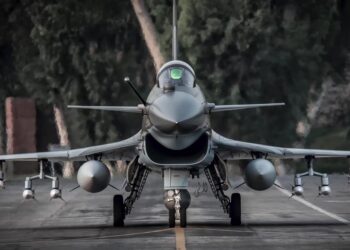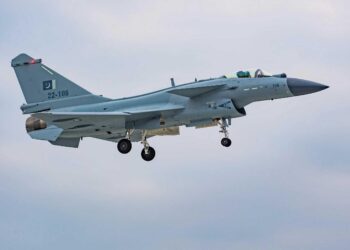WASHINGTON: Current and potential U.S. adversaries seek to employ asymmetrical weapons, such as improvised explosive devices and cyber warfare, as a means to confront U.S. military superiority in conventional conflict, Deputy Defense Secretary William J. Lynn III said here Jan. 21.
“Our dominance in conventional warfare has led adversaries to seek new avenues to challenge us,” Mr. Lynn told military and civilian attendees at the 38th Institute for Foreign Policy Analysis-Fletcher Conference on National Security Strategy and Policy.
The nature of armed conflict, Mr. Lynn said, has changed since the Cold War era, when military doctrine was developed to deal with an envisioned clash of massed conventional air and land forces on European battlefields.
Today, insurgents in Afghanistan and Iraq employ low-tech improvised explosive devices “that penetrate even the most heavily defended armor,” he said, while terrorists and rogue nations seek to acquire weapons of mass destruction.
However, the U.S. military is employing new methods and technology to meet asymmetrical challenges, he said, pointing to the increased use of unmanned aircraft in those theaters of operation.
For example, UAs fitted with cameras can identify and track insurgent activities, such as the placing of roadside bombs. And, UAs also can employ missiles to attack the enemy, while space-based satellites provide added intelligence information.
“Because of a significant investment in intelligence, surveillance and reconnaissance (capabilities), commanders receive actionable intelligence in minutes rather than in hours,” Mr. Lynn said. “Unmanned aircraft now combine surveillance with attack abilities.”
The rapid development and fielding of unmanned aerial systems to combat zones, he said, exemplifies “one of many shifts we have taken across the department to focus our resources on the wars we are fighting and the new threats that we face.”
Yet, Mr. Lynn said, the U.S. military also must be prepared to confront a potential enemy that fights a conventional conflict, as well as adversaries who may choose to wage both asymmetrical and conventional war.
In view of the changing nature of warfare, Mr. Lynn offered four overriding space and aerospace imperatives the U.S. military must follow in the early 21st century:
- Continue redirecting resources to defeat unconventional threats, while retaining the ability to fight conventional wars.
- Maintain U.S. military air superiority by investing in new-generation tactical aircraft such as the F-35 Lightning II joint strike fighter.
- Develop a next-generation, long-range strike capability.
- Ensure access to space and use of U.S. space-based assets.
“Space, much like cyber-space, is no longer a domain left uncontested by potential adversaries,” Mr. Lynn said. “So, to protect our technological advantage in space-based platforms, we must reduce their vulnerability to attack and to disruption.”
Additionally, Mr. Lynn said, the cyber-warfare threat is a major national security issue that has captured his attention.
“If we don’t maintain our capabilities to defend our networks in the face of an attack,” he said, “the consequences for our military — and indeed, for our whole national security — could be dire.”
Mr. Lynn cited a 1998 cyber attack launched by two California teenagers and an overseas accomplice who targeted U.S. military computer networks.
“The attacks were coordinated and aimed at crucial military (computer) systems,” Mr. Lynn said. “The threat was so serious that the president was briefed.”
Investigators, he said, traced the origins of the attack and the instigators were apprehended and tried on charges of computer assault.
Yet, that 1998 computer attack “was child’s play,” Mr. Lynn said, noting the frequency and sophistication of attacks have increased exponentially during the past decade.
“Cyber (warfare) is an especially asymmetric technology; the low cost of computing devices means that our adversaries don’t have to build an expensive weapons system like a fifth-generation fighter to pose a disproportional threat,” Mr. Lynn explained.
Consequently, he said, many militaries are building offensive cyber capabilities.
The Defense Department today operates 15,000 computer networks across 4,000 military installations in 88 countries, Mr. Lynn said, noting the department spends billions of dollars each year to administer, monitor and defend those networks.
Because of the seriousness of the cyber threat, he said, the Defense Department has over the past 10 years built layered and robust cyber defenses.
And, in June 2009, Defense Secretary Robert M. Gates directed the establishment of U.S. Cyber Command, a military sub-command focused on cyber security, Mr. Lynn noted. Cyber Command is in the process of being stood up and is to be based at Fort George G. Meade, Md.
“Cyber Command will bring together more than a half a dozen intelligence and military organizations in support of three overlapping categories of cyber operations,” he said.
The command, he said, will protect defense computer networks, coordinate all defense computer operations and provide full-spectrum support for all military and counterterrorism missions, and stand by to support civil authorities and industry partners on an as-needed basis.
“Combining offensive and defensive capabilities under a single roof and bringing those together with the intelligence we need to anticipate attacks will make our cyber operations more effective,” Mr. Lynn said.









